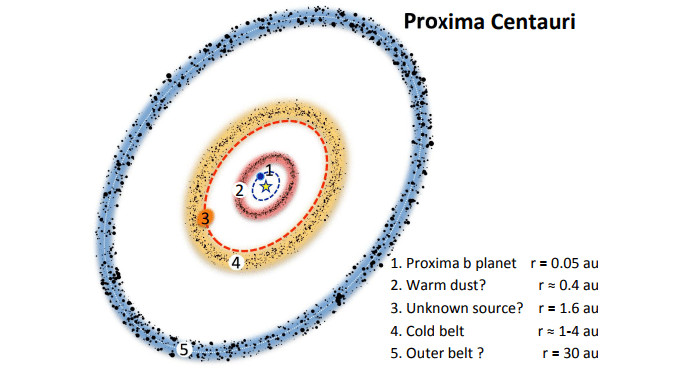Discover many interesting things in the star closest to the solar system
The Red dwarf Proxima Centauri - the Earth-like planet's shelter, may contain a more complex planetary system than we thought.
Scientists used data from the ALMA Observatory in Chile to study the star discovered last year. Through it, they saw a dim light , shaped like a dust belt surrounding Proxima Centauri that stretched several hundred million kilometers.

The dust belt (which may include ice and ice blocks) is extremely cold when the temperature is around -230 degrees C. (Photo: ESO).
It is estimated that the dust belt (which may include ice and ice blocks) is extremely cold when the temperature is around -230 degrees Celsius. It is as cold as the Kuiper belt within the solar system itself.
The cosmic dust belt is often left over from the accretion disks of materials around the star and forming planets. This means that there may be many planets that existed in Proxima Centauri that we don't know.
"Dust around Proxima is very important because it is the first sign of the existence of a complex planetary system. Not just a single planet orbits a star near Earth as much as we think. initially guessed , "said astronomer Guillem Anglada of the Andalusia Institute of Astrophysics (IAA).
According to the team, the data even shows that the possibility of another dust belt is 10 times colder than the star's far side. The group of scientists arranged the signs they discovered into a preliminary draft of the planetary system around Proxima Centauri. They were extremely excited when they tracked a place away from the star at a distance of 1.6 astronomical units.
"We are gathering clues about a ring of dust surrounding a giant planet that has yet to be discovered. This really inspires scientists," the team said. This is marked with a 3 above the sketch (below).

Sketch of the research team.(Photo: Anglada).
Although long-term data from Proxima Centauri observations has not yet yielded results, researchers are not discouraged."Additional observations are being made to confirm or eliminate this attraction," they concluded.
So far, we have only confirmed the existence of a planet in the Proxima Centauri system. The discoveries surrounding Earth's neighbor - Proxima b have yet to show a positive sign.
In August 2016, ESO scientists finally confirmed the existence of the planet on this red dwarf, making the whole world happy because this is the closest star to the solar system. who can live. Only two months later, new calculations show that Proxima b is actually capable of being covered in water and has a thin atmosphere. Both good signs reinforce the hypothesis of a life-sustaining potential on this planet.
Later that year, we have another information: Proxima is just one and the winds here make the star a harsh place. Moreover, the weather in space eroded the atmosphere and the surface, making it a 'dead world'. Of course, with the latest research, we have the right to hope for the possibility of living on this planet again. Because according to scientists, under certain conditions Proxima b can become a paradise with water and atmosphere.
When is a probe passing here and providing more data about the red dwarf star to us - still a question. But at this point, we know for sure that Proxima Centauri, the master star, contains attractive dust rings and probably possesses many mysterious planets - so interstellar exploration should be more concerned.
Anglada researcher said: "Proxima Centauri must have a rich interactive history of many new planets that could lead to the formation of such a dust belt." Besides, the researchers noted that by how to constantly study the Earth's neighbor, we will better understand the birth of the Solar System.
IAA astronomer Pedro Amado said: 'Combining the study of planetary disks around young stars, details of the process of forming Earth and the Solar System about 4,600 million years ago will be revealed. What we are witnessing is just an appetizer in the upcoming hearty party. '
- Portrait of the star closest to the solar system
- Interesting things about the solar system
- Will the Solar System have 9 planets again thanks to this new discovery?
- Why does the star system have 3 super new Earth?
- Discover the nearby neighborhood of the solar system
- Your planet is closest to Earth
- The planet closest to the Solar System is actually just a planet.
- The star planets TRAPPIST-1 could not survive
- Discover the oldest solar system outside the solar system
- Open the way to form the solar system
- The Sun hypothesis steals the ninth planet from another star
- Super Earth to the solar system?
 Van Allen's belt and evidence that the Apollo 11 mission to the Moon was myth
Van Allen's belt and evidence that the Apollo 11 mission to the Moon was myth The levels of civilization in the universe (Kardashev scale)
The levels of civilization in the universe (Kardashev scale) Today Mars, the sun and the Earth are aligned
Today Mars, the sun and the Earth are aligned The Amazon owner announced a secret plan to build a space base for thousands of people
The Amazon owner announced a secret plan to build a space base for thousands of people